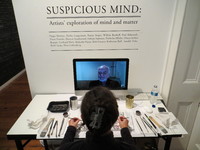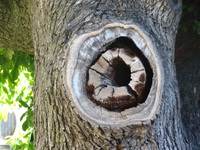Items
Site
The Medicine Chest
keywords is exactly
Hiddingh campus
-

The Mother of all Firewalls
'The Mother of all Firewalls' (2012), is a sculptural piece by Kim Gurney made from beeswax, gold glitter, bitumen, repurposed tiles, rabbit skin and glue, which seems to depict an EEG graph in its format but in reality references a graph plotted by Google Insights after Gurney inputted a range of new words that emerged from the ‘Eurogeddon’ of 2012, showing their incidence in news reports pertaining to this financial crisis between 2008 and 2012. -

Suspicious Mind (Performance)
UCT’s Professor Mark Solms, then chairperson of the NPSA and one of the main organisers of the annual international Neuropsychoanalysis conference (2013), highlights Katherine Bull’s contribution to the 'Suspicious Mind' exhibition as one that stood out for him. His interpretation of the ambidextrous portraits she painted of him reveals an insider’s insight of an outsider object and shows how Bull’s artistic process enables theories postulated in his field to manifest in unusual ways: "She painted my double portrait – with her left and right hand simultaneously – over Skype, and she did the same of my beloved (now deceased) colleague Jaak Panksepp on site at the exhibition. I am the grateful owner of both of those double portraits. They hang in my sitting room, so I am reminded daily of the conference and of my departed friend. It is fascinating to see how Bull’s two hemisphere’s processed both me and Jaak each in their different ways. In both of our cases, her left hemisphere painted us with heads that sloped slightly to the right and contained more precise detail; while her right hemisphere painted us more impressionistically, but I think captured our ‘souls’ more accurately" (Liebenberg 2021: 233 - 234) -

Sudden death of city dentist
Newspaper article about Walter Floyd's death -

The South African College
“UCT was founded in 1829 as the South African College, a high school for boys. The College had a small tertiary-education facility that grew substantially after 1880, when the discovery of gold and diamonds in the north – and the resulting demand for skills in mining – gave it the financial boost it needed to grow. The College developed into a fully fledged university during the period 1880 to 1900, thanks to increased funding from private sources and the government. During these years, the College built its first dedicated science laboratories, and started the departments of mineralogy and geology to meet the need for skilled personnel in the country's emerging diamond and gold-mining industries” (University of Cape Town 2021). -

Donahue near-miss
An artwork purchased in 2015 from the Michaelis School of Fine Art Graduate Show, created by then student, Tess Metcalf. -

Hamish Email
An email between artist-curator and Dr Hamish Robertson. Robertson was invited to Hiddingh campus in his capacity as entomologist (and then Director Natural History Collections at Iziko Museums of South Africa) to assess the environment in terms of biodiversity prior to the staging of the 'Where the Wild Things Are' exhibition. -

Lacuna (Part one)
"It is interesting to note that the botanical origins of most of these medicines were from outside of Africa, especially if one considers the long history of the Cape as a point on the trade routes where ill sailors regularly disembarked and drew on the knowledge of the Khoekhoe traditional healers for treatment and herbal cures (Laidler & Gelfand 1971: 44). The Cape flora offered a plenitude of medicinal resources and these healers (who were skilled in botany, surgery and medicine) used them in a variety of healing practices . The exclusion of local botanical remedies in the BWC No. 254 medicine chest can be attributed to many factors" (Liebenberg 2021: 67). -

Lacuna (Part two)
An ill English Oak on Hiddingh Campus, Michaelis School of Fine Art, University of Cape Town. English oaks were first brought into the country by the early settlers and were one of the first exotic tree species to be planted in South Africa, shortly after Van Riebeek’s arrival in 1652. He explained that in South Africa, these trees do not grow as old as they would have in Europe. The high temperatures cause these trees to grow faster than their species back home, and because of this, their centers start rotting over an extended period of time. The center part of the wood – the heart – is affected by this occurrence and hollowed out over time.


